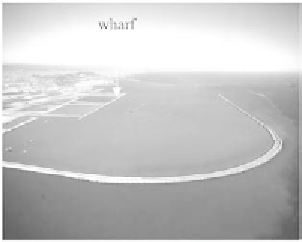Geoscience Reference
In-Depth Information
(a) position of the new wharf (b) after the liquefaction
Figure 16.3 Barcelona harbour
On 1 January 2007 a sudden unexpected collapse took place: 600 metre of the
quay wall and a large part of the fill, already well advanced, disappeared (Fig
16.3b). Eyewitnesses reported that 16 massive caissons were displaced, some over
80 metres within a few minutes.
In general, hydraulic fill mud settles slowly. Particularly for fine soils, it may
take days. During filling a settling mud slope advances in a dynamic way with
successive local sliding. The mud may have a temporary density significantly
higher than water, at times even up to 1800 kg/m
3
. Such mud fluid induces
additional excess pore pressures in the subsoil. Accordingly, local shear resistance
will decrease, making the soil's stability vulnerable.
The massive slide, which occurred at the end of the fill operations, was most
probably caused by high mud level, while the front slope of the fresh mud reached
its deepest and steepest size, and excess pore pressures in adjacent zones due to the
mud weight were at their peak. Because an advancing sedimentation front during
hydraulic fill is unstable, successive small slides took place, one of which may
have triggered the massive slide. Some caissons became instable, mud penetrating
under the tilting caissons working as a lubricant, and next gravity caused the
fluidised mass to move and expand, taking with it many more caissons into the
recently deepened harbour. It is essential to include the mud-weight induced pore
pressure effect in the surroundings in the design of temporary works.
B
WAVES ON SEABED
The transient pore pressure generation in a stratified seabed due to waves is not
trivial. The variance in permeability and compressibility of submerged soil layers
may give rise to locally unexpected effective stress changes and in some locations
excess pore pressures that exceed common limits and seem to have a negative
retardation. It may reduce the local seabed stability and resistance against erosion
or liquefaction. Some of these phenomena are explained.
One-dimensional cyclic consolidation
A method that provides straightforward solutions is the method of harmonic
oscillation. A cyclic loading is applied and the response after many cycles (the
steady cyclic state) is considered. The method is based on complex algebra. It will


Search WWH ::

Custom Search